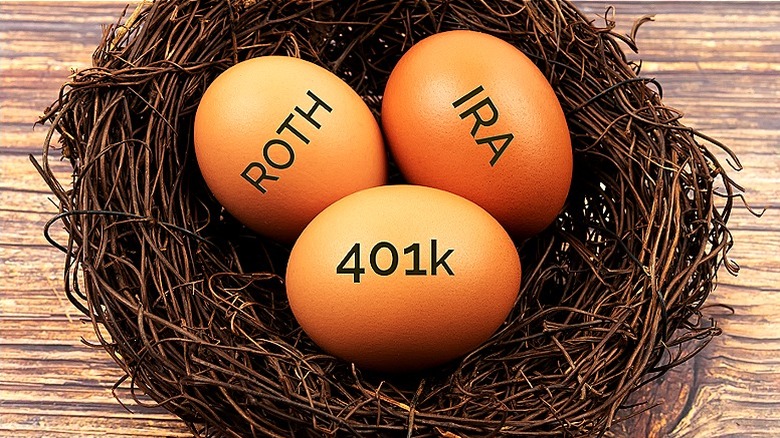Actions You Need To Take If You Retire Early To Bridge The Income Gap
Launching your retirement is almost entirely a financial decision. You won't be able to stop working if your finances demand a continued influx of salary checks. However, once your retirement accounts reach their magic numbers, you might consider hanging up your boots early; perhaps you're earning the U.S. average of just under $60,000, according to Forbes Advisor's analysis, giving you a savings target between $450,000 and $810,000 at 65.
This all sounds great, but one thing is missing in this equation. The rules surrounding withdrawal timelines to take advantage of tax benefits are clear, and they don't lend themselves well to early retirement. Taking distribution from a Roth or traditional IRA, or a 401(k) requires you to wait until you're 59 ½ in order to enjoy the tax savings that all the previous years of investments have built. Retiring before this age will see you either forfeiting these tax advantages and paying a premium to access your money, or finding an alternative to bridge the gap. Here's how to make it work if you decide you're ready to retire from work but can't use your savings just yet.
Using the 72(t) rule for early IRA withdrawals
First of all, the IRS notes that you can take distributions "made as part of a series of substantially equal periodic payments [SEPP] over your life expectancy." This is known as rule 72(t) and the IRS provides for three calculation options to make these distributions. Each allows for penalty-free distributions, even before you reach the key age number.
These must take place over at least five years and be drawn down at a set schedule in order to qualify as part of a SEPP strategy. If you are arriving at a retirement opportunity in your late 50s, you might consider utilizing this to generate a steady influx of retirement income that bridges the gap between the present and a birthday in your 60s that can open up eligibility to Social Security benefits and standard retirement account distributions. This strategy doesn't make sense in most cases when seeking emergency capital earlier in life, however.
To take advantage of rule 72(t) distributions, it's generally a good idea to speak with a retirement-planning specialist so you don't run afoul of the IRS' rules governing this approach. It can be difficult to know what calculation choice is right for your needs now and the preservation of your remaining funds for later use. As well, reevaluating your distribution schedule and compliance on a regular basis must form a part of your strategy when considering SEPP withdrawals. (Read about Social Security rules that can drastically increase your monthly benefits.)
Making a shift to income-generating assets
Investors often seek out solid growth options when building their retirement savings strategy. But investments placed into assets that produce income-generating potential are also valuable, especially for those nearing retirement or transitioning into it. Income-generating assets are those that don't pack on as much long-term value and instead pay out higher dividends. The difference allows an investor to maintain their ownership stake while still taking advantage of interim value extractions.
For example, rental property. A rental property creates monthly income without affecting the equity an owner has in the property. An index fund focused on growth, on the other hand, might offer you regular dividend payments but in order to really capitalize on its value you'll need to sell shares. This dilutes your ownership position and can eventually eliminate your asset entirely over a long enough timeline.
Investing in real estate is a great way to create lasting passive income, but it's not the only option. Investments like dividend aristocrats and annuities also produce better-than-average payout rates without affecting the ownership position you've taken. As you prepare for a transition into retirement, it's worth considering a shift of your liquid assets into something that produces income in order to fund your ongoing lifestyle rather than focusing solely on long-term growth that will help later. (Check out five ways of making passive income that are even better than real estate.)
Taking advantage of your home's equity
Your home is also a potent source of financial strength that can help bridge an early-retirement income gap. Owning a home isn't just a great way to put a roof over your head, it's also a financial commitment and fallback. By purchasing a home, you're investing in a dual-purpose financial asset that grows with you. CEIC Data reports an annualized average growth of 5.5% between 1992 and 2024 in real estate value, meaning your home's value increases every year by more than you'd earn in a high-yield savings account, yet less than a typical return from index-fund investments. However, your money is tied up (partially) in an asset that also gives you shelter and a place to grow and thrive. That's an invaluable component of homeownership. Because it's also a financial asset, though, your home can serve as a means of developing retirement income if necessary.
In addition to unique drawdown strategies or key investment options, you might also consider a HELOC or some other home equity loan or cash-out mortgage refinancing. A HELOC is like a credit card account that's linked to your home's value, and its repayment periods can be pushed far out into the future. This means you may be able to use your home's equity like a revolving line of credit (note that careful management here is essential), and then pay it back after you pass your targeted Social Security benefits start date or that age threshold that keeps your retirement assets locked away.
HELOC financing is often quite inexpensive compared to other lending options, making it a potentially great way to borrow against future repayment funding at a favorable rate. (On that note, here's how a significant drop in home value could affect your HELOC.)



